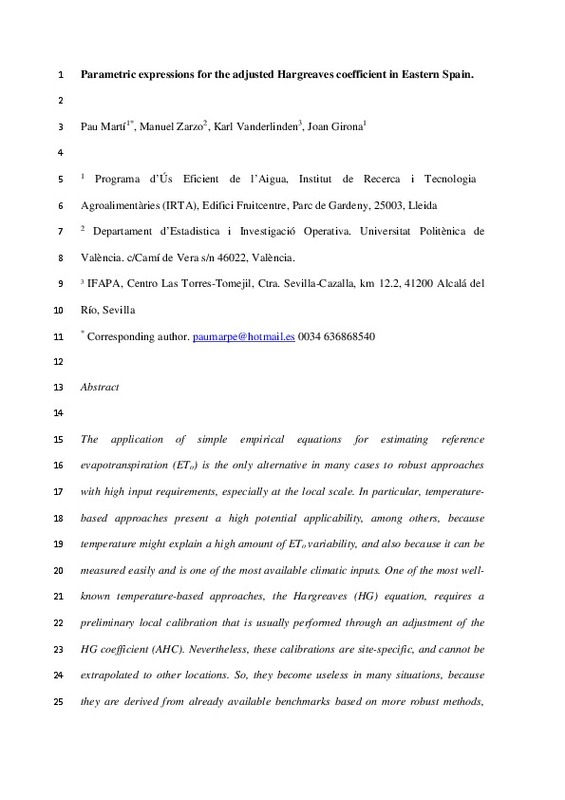|
Resumen:
|
The application of simple empirical equations for estimating reference evapotranspiration (ETo) is the
only alternative in many cases to robust approaches with high input requirements, especially at the local
scale. In ...[+]
The application of simple empirical equations for estimating reference evapotranspiration (ETo) is the
only alternative in many cases to robust approaches with high input requirements, especially at the local
scale. In particular, temperature-based approaches present a high potential applicability, among others,
because temperature might explain a high amount of ETo variability, and also because it can be measured
easily and is one of the most available climatic inputs. One of the most well-known temperature-based
approaches, the Hargreaves (HG) equation, requires a preliminary local calibration that is usually performed
through an adjustment of the HG coefficient (AHC). Nevertheless, these calibrations are sitespecific,
and cannot be extrapolated to other locations. So, they become useless in many situations,
because they are derived from already available benchmarks based on more robust methods, which will
be applied in practice. Therefore, the development of accurate equations for estimating AHC at local scale
becomes a relevant task. This paper analyses the performance of calibrated and non-calibrated HG equations
at 30 stations in Eastern Spain at daily, weekly, fortnightly and monthly scales. Moreover, multiple
linear regression was applied for estimating AHC based on different inputs, and the resulting equations
yielded higher performance accuracy than the non-calibrated HG estimates. The approach relying on the
ratio mean temperature to temperature range did not provide suitable AHC estimations, and was highly
improved by splitting it into two independent predictors. Temperature-based equations were improved
by incorporating geographical inputs. Finally, the model relying on temperature and geographic inputs
was further improved by incorporating wind speed, even just with simple qualitative information about
wind category (e.g. poorly vs. highly windy). The accuracy of the calibrated and non-calibrated HG estimates
increased for longer time steps (daily < weekly < fortnightly < monthly), although with a decreasing
accuracy improvement rate. The variability of goodness-of-fit between AHC models was translated
into lower variability of accuracy between the corresponding HG calibrated ETo estimates, because a single
AHC was applied per station. The AHC fluctuations throughout the year suggest the convenience of
using monthly or, at least, seasonal models.
2015 Elsevier B.V. All rights reserved.
[-]
|






![[Cerrado]](/themes/UPV/images/candado.png)



